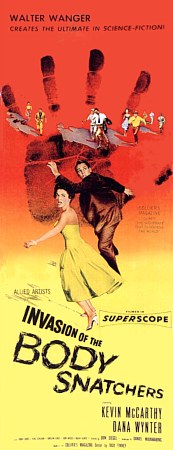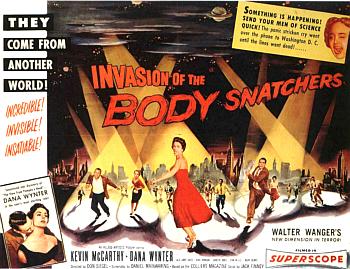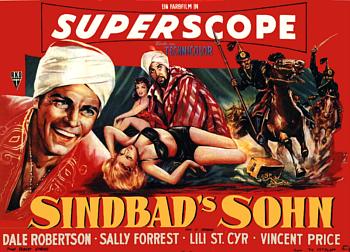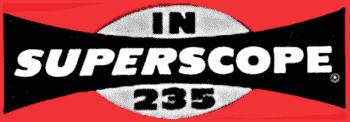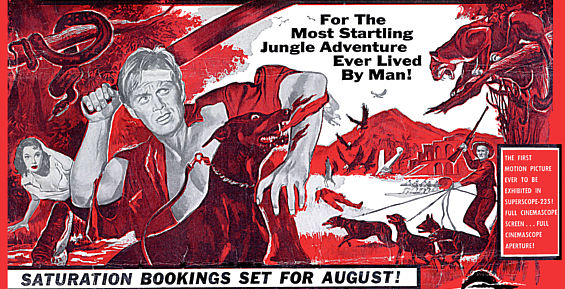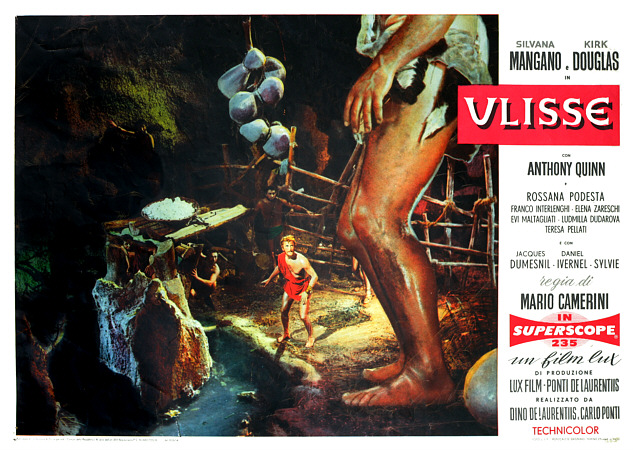
The Rich Man's
Poor Man's Version of CinemaScope
Superscope was used in nine RKO Technicolor productions from 1955 thru 1957, and a few re-releases of older films including a bastardized conversion of Walt Disney's Fantasia which featured the original optical Fantasound system adapted to four track magnetic stereo. Black and white films were produced in the process by RKO and other small studios. While the process seemed to be reserved for the most forgettable of films, a few were better than average, notably Allied Artist's (the old Monogram studio) release of Walter Wanger's Invasion of the Body Snatchers. Like some others, that film suffered from the composition created by Superscope because it had not been photographed with the format conversion in mind.
Above: Detail from poster - The movie wasn't filmed in Superscope, that decision came after it was completed. Since it was a black & white film, the grain issue was not as critical.
Right: Detail from Poster - Kevin McCarthy was the only man in the known universe who had a valid reason for not wanting to sleep with gorgeous Dana Wynter. The curator might not have made the same decision.
Superscope evolved during its brief life. It had originally been planned to use 1.5x squeeze lenses, but this was balked at by exhibitors that already had 2x CinemaScope optics, so the centered frame was initially used. The need to readjust projector or lens alignment was solved by shifting the frame to use a common centerline with CinemaScope, and finally the system evolved into Superscope 235. Here the extraction area was further cropped down to yield a 2.35:1 aspect ratio and the prints were made using CinemaScope compatible specifications. This further exaggerated the problem of film grain which was considered to be excessive even in the older format. Today it is difficult to document which Superscope films were made in the 2:1 ratio and which were done in the 2.35:1 ratio. (See more on Superscope 235 below) Whichever system was used, it was inferior in image quality to virtually all other widescreen systems.
Above: German poster for RKO's Son of Sinbad from 1955, indicating that Superscope was a bit bigger deal in Europe than in the U.S. At least it merited more room on the posters. Son of Sinbad had a unique history. It had been made in 1953 using Technicolor's special three-strip 3-D rig, one of the few films to do so. For whatever reason, R.K.O. sat on the film for nearly two years and finally released it using Superscope. Not a terrible film, but not a classic. It did feature beautiful stripper Lili St. Cyr in a rare screen appearance and that's enough to make the film interesting to the curator.
SUPERSCOPE Changes Shape
Run For The Sun, first Superscope 235 feature, released in August, 1956.
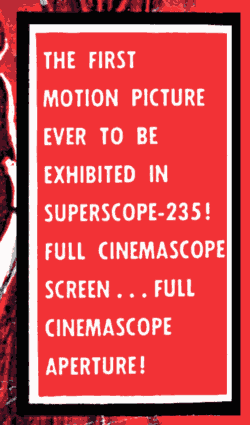
As mentioned earlier, Superscope came into existence when it was believed that the film industry would be supporting several different wide screen aspect ratios. (Giving birth to new variable lenses from Superscope, Panavision, and Hi-Lux to name a few) CinemaScope was still primarily a 2.55:1 system with magnetic stereophonic sound and VistaVision was promising an anamorphic print with a 2:1 aspect ratio having a 1.5x squeeze. The Tushinskys took Paramount at their word and adopted a 2:1 aspect ratio thinking they would benefit from the support of exhibitors that favored something less than CinemaScope offered. Paramount's failure to follow through with a 1.5x anamorphic show print hurt Superscope because it became necessary for them to then utilize the 2x squeeze of CinemaScope, meaning that their image would take up less space on the finished print. New York Times film critic Bosley Crowther had severely criticized Vera Cruz for its fuzzy photography and blobby colors. A year and a half later, Crowther made not a mention of the screen image in the new Superscope 235 film Run For The Sun, a ripping third remake of "The Most Dangerous Game". While Superscope 235 made less use of the original camera negative area, it gained some quality back in getting as much print real estate as CinemaScope and Technicolor's vastly improved final dye transfer system, which came on line in mid 1955, plus improvements in Eastmancolor negative. Seen here are excerpts from United Artists' ad campaign for Run For The Sun.
Superscope 235 ad material courtesy of Roland Lataille.
The Tushinsky's and R.K.O. finally figured out that their 2:1 aspect ratio was not going over all that well. Here is an ad from Motion Picture Herald showing that Superscope could be made not only in the 2.35:1 format but also in the four track magnetic stereo 2.55:1 format.
Courtesy of Roland Lataille
The Ponti-De Laurentiis production of Ulysses was released in 1954 in Italy but its technical aspects are really confusing. It was originally slated to be photographed in 3-D it but there is no apparent evidence that it was shot that way. Early references state it was shown at a 1.66:1 "wide screen" ratio but being made in Europe in 1954 it was obviously shot for traditional 1.37:1 whether flat or 3-D. Above is an Italian lobby card for the film stating that it was in Superscope 235, a format that was introduced almost 2 1/2 years after the film was made and such a high degree of cropping would certainly compromise the composition of the image as well as compromising image quality. This stuff can get really confusing, can't it?
SUPERSCOPE GOES RETRO
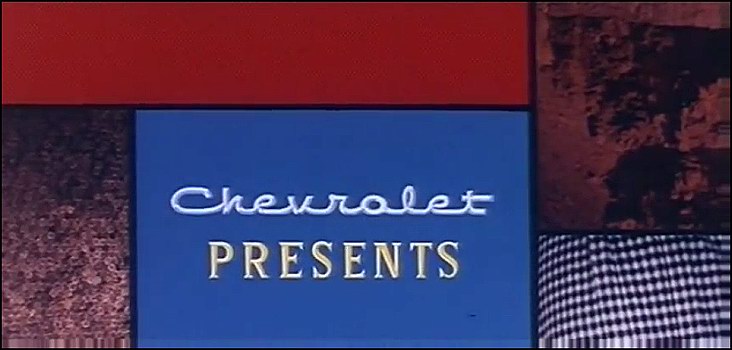
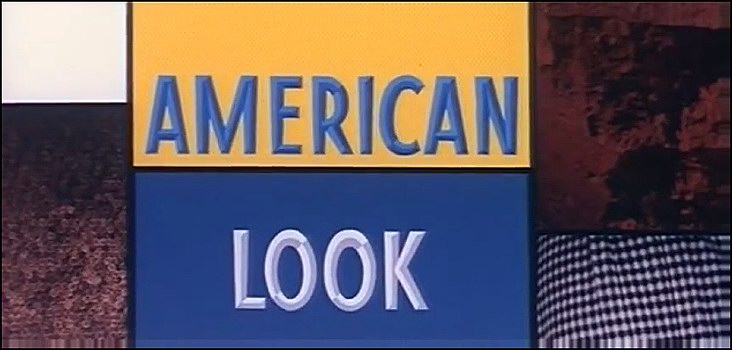
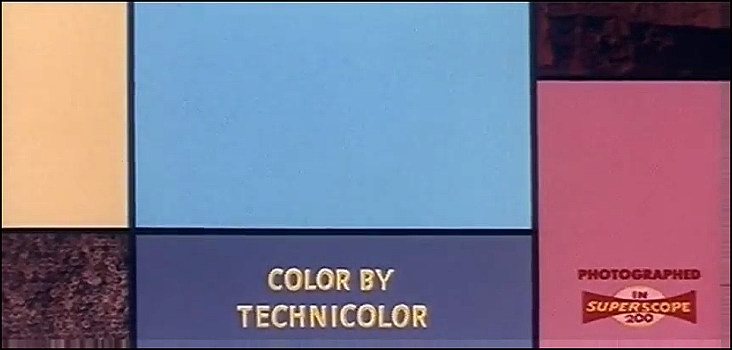
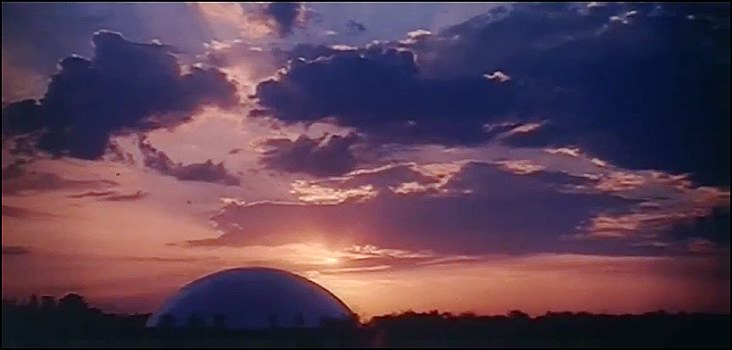
Seen above are four frames from a General Motors sponsored trade show film that managed to make it to YouTube. In the curator's opinion it rates as one of the most boring attempts at an early infomercial. Only of interest is the fact that the film is credited as being photographed in Superscope 200. This would indicate that the film had been printed to provide a 2:1 screen ratio, the original format developed by the Tushinsky Brothers. While theatrical features had gone to the CinemaScope compatible 2.35:1 screen format in 1956, this film was made in 1958. The Superscope 200 logo shown is the only example of it seen by your curator. Of course by now you know that no movie was ever photographed IN Superscope. Instead they may have been photographed FOR Superscope.
The death of the RKO studio in 1958 left a number of films in the lurch. The last films in the production list were completed and then distribution arrangements were made with other studios for their ultimate release. It's hard to classify a film like The Naked and the Dead as a Warner Bros or RKO film. Nowadays that's not a problem as both the old Warner and old RKO libraries are now owned by AOL-Time-Warner. (It never fails to amaze me that the AOL part of that entity hasn't totally screwed up the rest of the organization.)
Depending on the ad materials you look at, The Naked and the Dead was either made in R-K-O Scope or Warnerscope. Either way it's still the same system as Superscope. Now what the difference is between the RKO sponsored Superscope and R-K-O Scope is not clear to your Curator. It may indicate that the Tushinsky printer lenses were not used, and thus the brothers were being screwed out of their royalty, it's just not clear. Warners used the system on several films that they produced such as the 1959 James Garner World War II film, Up Periscope! which the Curator fondly remembers as being a nice diversion for a 12 year old boy.
At left, a trade ad for Up Periscope! in Warnerscope and Technicolor
In the early 1980's the Superscope concept was resurrected in its 2.35:1 version and came to be referred to as Super 35. The super infers that the frame area is larger than the Academy format, in fact it's the old silent aperture, rather than indicating that the picture quality is super. As mentioned earlier, the benefits of the system are the fact that standard spherical lenses and potentially lower light levels are required in photography. The prime reason for its application is the fact that it becomes very easy to create a television version of a widescreen film. The theatrical print (sometimes even in outrageous 70mm blowup) is vastly inferior to a conventional Panavision anamorphic production. Producers, rather than taking advantage of continually improving film stocks to present a better image, use it to reduce their inconvenience in production and aftermarket sales at the expense of the screen image. One of the chief proponents of the Super 35 format is director James Cameron who has produced a number of successful action films on mega million dollar budgets. Fortunately the motion picture screen is rapidly approaching postage stamp size and the all important television image is growing, so formats such as Super 35 won't display their inherent shortcomings so easily. End of editorial.
E-mail the author
CLICK HERE
©1996 - 2004 The American WideScreen Museum
http://www.widescreenmuseum.com
Martin Hart, Curator
